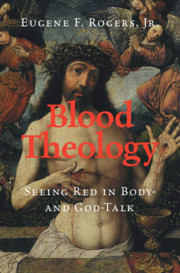Book contents
- Blood Theology
- Reviews
- Blood Theology
- Copyright page
- Dedication
- Contents
- Acknowledgments
- Part I Why We See Red
- Part II Blood Seeps in Where It Hardly Seems to Belong
- 2 Blood after Isaac
- 3 Blood after Leviticus
- 4 Blood after the Last Supper
- Part III Blood Makes a Language in Which to Conduct Disputes
- Part IV The Blood of God at the Heart of Things
- Appendix Review of Gil Anidjar’s Blood: A Critique of Christianity
- Sources Cited or Consulted
- Scripture Index
- Subject Index
4 - Blood after the Last Supper
Jesus and the Gender of Blood
from Part II - Blood Seeps in Where It Hardly Seems to Belong
Published online by Cambridge University Press: 22 March 2021
- Blood Theology
- Reviews
- Blood Theology
- Copyright page
- Dedication
- Contents
- Acknowledgments
- Part I Why We See Red
- Part II Blood Seeps in Where It Hardly Seems to Belong
- 2 Blood after Isaac
- 3 Blood after Leviticus
- 4 Blood after the Last Supper
- Part III Blood Makes a Language in Which to Conduct Disputes
- Part IV The Blood of God at the Heart of Things
- Appendix Review of Gil Anidjar’s Blood: A Critique of Christianity
- Sources Cited or Consulted
- Scripture Index
- Subject Index
Summary
“Jesus and the Gender of Blood.” Here’s a place blood seeps in where it hardly seems to belong: Crucifixion kills not by blood loss but suffocation. Neither crucifixion nor a common meal requires blood. Hands and feet can be lashed without nails. Why must Jesus bleed? Gospel writers portray Jesus at the Last Supper as mobilizing the language of blood to transform a structure of violent oppression – crucifixion – into a peaceful feast. The image of the Woman with a Flow of Blood, read as dysmenorrhea, recognizes a kinship: three gospels identify both the woman and Jesus with their bleeding, as leaky. The stories feminize Jesus by turning his blood away from male-gendered violence and toward female-gendered purposes of new life and rebirth. Reflections on the Eucharist and taboo.
Keywords
- Type
- Chapter
- Information
- Blood TheologySeeing Red in Body- and God-Talk, pp. 83 - 114Publisher: Cambridge University PressPrint publication year: 2021

